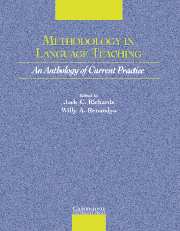Book contents
- Frontmatter
- Contents
- Acknowledgments
- Introduction
- Section I Approaches to Teaching
- Section 2 Lesson Planning and Classroom Management
- Section 3 Classroom Dynamics
- Section 4 Syllabus Design and Instructional Materials
- Section 5 Task and Project Work
- Section 6 Learning Strategies
- Section 7 Teaching Grammar
- Section 8 Teaching Pronunciation
- Section 9 Teaching Speaking
- Section 10 Teaching Listening
- Section 11 Teaching Vocabulary
- Section 12 Teaching Reading
- Section 13 Teaching Writing
- Chapter 29 Ten Steps in Planning a Writing Course and Training Teachers of Writing
- Chapter 30 The Writing Process and Process Writing
- Chapter 31 A Genre-Based Approach to Content Writing Instruction
- Chapter 32 Teaching Students to Self-Edit
- Section 14 Assessment
- Section 15 Technologies in the Classroom
- Section 16 Professional Development
- Credits
- Author Index
- Subject Index
- References
Chapter 31 - A Genre-Based Approach to Content Writing Instruction
Published online by Cambridge University Press: 10 November 2010
- Frontmatter
- Contents
- Acknowledgments
- Introduction
- Section I Approaches to Teaching
- Section 2 Lesson Planning and Classroom Management
- Section 3 Classroom Dynamics
- Section 4 Syllabus Design and Instructional Materials
- Section 5 Task and Project Work
- Section 6 Learning Strategies
- Section 7 Teaching Grammar
- Section 8 Teaching Pronunciation
- Section 9 Teaching Speaking
- Section 10 Teaching Listening
- Section 11 Teaching Vocabulary
- Section 12 Teaching Reading
- Section 13 Teaching Writing
- Chapter 29 Ten Steps in Planning a Writing Course and Training Teachers of Writing
- Chapter 30 The Writing Process and Process Writing
- Chapter 31 A Genre-Based Approach to Content Writing Instruction
- Chapter 32 Teaching Students to Self-Edit
- Section 14 Assessment
- Section 15 Technologies in the Classroom
- Section 16 Professional Development
- Credits
- Author Index
- Subject Index
- References
Summary
INTRODUCTION
Just as students learn to control different oral registers, they must also be able to write in different ways for different purposes. Writing research has shown that students need to be exposed to and have practice with various genres in addition to narrative writing (e.g., Bereiter & Scardamalia, 1987; Langer, 1986; Martin, 1989; Perera, 1984). This is important for English L1 students and crucial for English L2 learners. Simply allowing students to write a lot will not necessarily provide sufficient practice in the types of writing valued for academic learning.
Since the past (1980s), researchers have been looking at the use of written language in elementary school classrooms. This research goes beyond merely describing the situations and features, often proposing strategies that may enhance student performance in various situations. Other researchers (Christie, 1992; Martin, 1989) have argued for the importance of language form and structure as an integral part of meaningful language use, a view that is being seen as increasingly more important for academic L2 contexts. Poynton (1986), for example, explored the types of writing elementary grade students do and highlights the importance of helping students to realize the different purposes of writing. This metalinguistic awareness empowers students and gives them tools to manipulate information and accomplish different purposes through writing.
- Type
- Chapter
- Information
- Methodology in Language TeachingAn Anthology of Current Practice, pp. 321 - 327Publisher: Cambridge University PressPrint publication year: 2002
References
- 5
- Cited by



